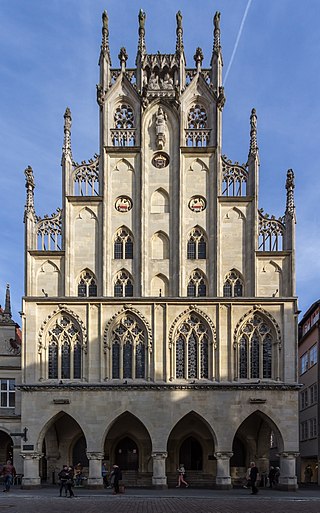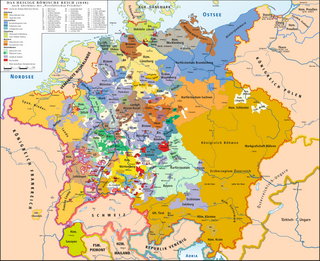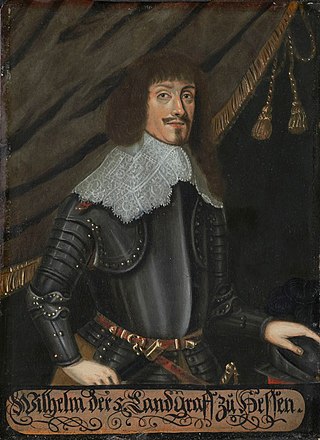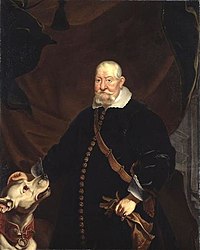
The Peace of Westphalia is the collective name for two peace treaties signed in October 1648 in the Westphalian cities of Osnabrück and Münster. They ended the Thirty Years' War (1618–1648) and brought peace to the Holy Roman Empire, closing a calamitous period of European history that killed approximately eight million people. Holy Roman Emperor Ferdinand III, the kingdoms of France and Sweden, and their respective allies among the princes of the Holy Roman Empire, participated in the treaties.

The Thirty Years' War was one of the longest and most destructive conflicts in European history, lasting from 1618 to 1648. Fought primarily in Central Europe, an estimated 4.5 to 8 million soldiers and civilians died as a result of battle, famine, or disease, while parts of present-day Germany reported population declines of over 50%. Related conflicts include the Eighty Years' War, the War of the Mantuan Succession, the Franco-Spanish War, the Torstenson War, the Dutch-Portuguese War, and the Portuguese Restoration War.

The Battle of Nördlingen took place on 6 September 1634 during the Thirty Years' War. A combined Imperial-Spanish force inflicted a crushing defeat on the Swedish-German army.

Ferdinand II was Holy Roman Emperor, King of Bohemia, Hungary, and Croatia from 1619 until his death in 1637. He was the son of Archduke Charles II of Inner Austria and Maria of Bavaria, who were devout Catholics. In 1590, when Ferdinand was 11 years old, they sent him to study at the Jesuits' college in Ingolstadt because they wanted to isolate him from the Lutheran nobles. A few months later, his father died, and he inherited Inner Austria–Styria, Carinthia, Carniola and smaller provinces. His cousin, Rudolf II, Holy Roman Emperor, who was the head of the Habsburg family, appointed regents to administer these lands.

The Edict of Restitution was proclaimed by Ferdinand II, Holy Roman Emperor in Vienna, on 6 March 1629, eleven years into the Thirty Years' War. Following Catholic military successes, Ferdinand hoped to restore control of land to that specified in the Peace of Augsburg (1555). That treaty's "Ecclesiastical Reservation" had prohibited further secularization of lands held by the Catholic church after 1555, disallowing any transfer of such lands to Protestant control. However, as the Holy Roman Empire descended into the Thirty Years' War, weak emperors had been unable to enforce this provision against Protestant encroachments.

The Three Bishoprics constituted a government of the Kingdom of France consisting of the dioceses of Metz, Verdun, and Toul within the Lorraine region. The three dioceses had been Prince-bishoprics of the Holy Roman Empire until they were seized by King Henry II of France between April and June 1552. At the end of the Thirty Years' War, they were officially ceded to France by the 1648 Peace of Westphalia.

John George I was Elector of Saxony from 1611 to 1656. He led Saxony through the Thirty Years' War, which dominated his 45-year reign.

The Heilbronn League was formed in the Free Imperial City of Heilbronn, on 23 April 1633, during the Thirty Years' War. Led by Sweden, it brought together various Protestant states in western and northern Germany. It was supported by Saxony and Brandenburg-Prussia, although they were not members.

The Battle of Jankau, also known as Jankov, Jankow, or Jankowitz, took place in central Bohemia on 6 March 1645, near modern Czech town of Jankov. One of the last major battles of the 1618 to 1648 Thirty Years' War, it was fought between Swedish and Imperial armies, each containing around 16,000 men. The more mobile and better led Swedes under Lennart Torstensson effectively destroyed their opponents, commanded by Melchior von Hatzfeldt. However, the devastation caused by decades of conflict meant armies now spent much of their time obtaining supplies, and the Swedes were unable to take advantage.

The Franco-Spanish War was fought from 1635 to 1659 between France and Spain, each supported by various allies at different points. The first phase, beginning in May 1635 and ending with the 1648 Peace of Westphalia, is considered a related conflict of the Thirty Years' War. The second phase continued until 1659, when France and Spain agreed to peace terms in the Treaty of the Pyrenees.
The Treaty of Hamburg, signed on 5 March 1638, was the ratification of the important Treaty of Wismar a full two years after it had been negotiated by Cardinal Richelieu of France and representatives of Queen Christina of Sweden. As it provided the Swedes with crucial funds to go on the offensive again, it was a major turning point of the Thirty Years' War.

The Treaty of Fontainebleau was signed on 30 May 1631 during the Thirty Years' War, at the Palace of Fontainebleau. It was a pact of mutual assistance between Maximilian I, Elector of Bavaria, and France, for a period of eight years.

The Battle of Herbsthausen, also known as the Battle of Mergentheim, took place near Bad Mergentheim, in the modern German state of Baden-Württemberg. Fought on 5 May 1645, during the Thirty Years War, it featured a French army led by Turenne, defeated by a Bavarian force under Franz von Mercy.

William V, a member of the House of Hesse, was Landgrave of Hesse-Kassel from 1627 to 1637. Having come to rule in unfavorable circumstances and in the midst of the Thirty Years' War, he continued to suffer losses of territory and wealth.

The Battle of Les Avins took place on 20 May 1635, outside the town of Les Avins, near Huy in modern Belgium, then part of the Bishopric of Liège. It was the first major engagement of the 1635 to 1659 Franco-Spanish War, a connected conflict of the Thirty Years' War.

The Treaty of Bärwalde, signed on 23 January 1631, was an agreement by France to provide Sweden financial support, following its intervention in the Thirty Years' War.

Amalie Elisabeth of Hanau-Münzenberg was Landgravine consort and Regent of Hesse-Kassel. She married the future William V, Landgrave of Hesse-Kassel in 1619 and became Landgravine upon his ascension to power in 1627. In 1637, military defeats forced her and William V into exile in East Frisia. Later that year, she became regent for their son William VI upon her husband's death. Through skillful diplomacy and military successes in the Thirty Years' War, she advanced the fortunes of Hesse-Kassel and influenced the Peace of Westphalia that brought the conflict to an end. She handed over an enlarged landgraviate to her son when she abdicated upon his majority in 1650. However, her health had deteriorated over the course of the war, and she died soon after her abdication in 1651.

The Diet of Regensburg of 1623 was a meeting of the Imperial States of the Holy Roman Empire convened by Holy Roman Emperor Ferdinand II. The meeting was not technically an imperial diet in the full sense, but a convention of princes or Deputationstag – a looser constitutional format giving the emperor greater leeway to make decisions without being bound by formal procedures. At the meeting, the Electorate of the Palatinate was transferred to Maximilian I of Bavaria. The meeting marked the high-water mark of imperial power during the Thirty Years' War.
The Hessian War, in its wider sense sometimes also called the Hessian Wars (Hessenkriege), was a drawn out conflict that took place between 1567 and 1648, sometimes pursued through diplomatic means, sometimes by military force, between branches of the princely House of Hesse, particularly between the Landgraviate of Hesse-Cassel and the Landgraviate of Hesse-Darmstadt. It was triggered by a division of inheritance following the death of the last landgrave of all Hesse, Philip I in 1567.
The imperial election of 1636 was an imperial election held to select the emperor of the Holy Roman Empire. It took place in Regensburg on December 22.


















